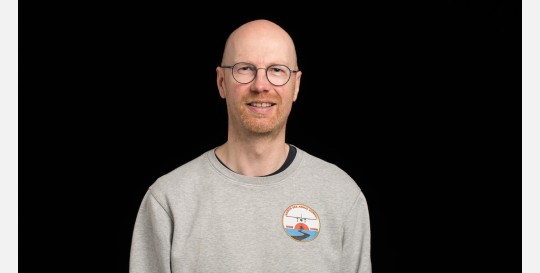Aerial Surveillance (SURV)
Background
In 1990 the Management Unit of the North Sea Mathematical Models, MUMM, began its programme of aerial surveillance of the North Sea. Similar initiatives were launched at this time by all the North Sea States to combat the incredibly large amount of illegal hydrocarbon pollution at sea. Since its implementation the main mission of the Belgian aerial surveillance plane is to seek out and identify marine pollution dumped by ships. The Ministry of Defence plane, a Britten Norman Islander, has been equipped with sensors dedicated to the detection and observation of petroleum hydrocarbon discharge, including a SLAR radar, an ultra-violet camera, an infra-red camera, a video camera and a powerful photographic camera. In 2004, the plane was taken out of circulation by the Ministry of Defence and was then transferred to the RBINS. It was given a civilian status and a new registration number: OO-MMM. This did not prevent the Ministry of Defence and the MUMM from continuing to work closely together after 2004: at present the Ministry of Defence always places the necessary pilots at the disposal of the MUMM for air surveillance missions. Moreover, the Ministry of Defence enables the MUMM to use professional security equipment and to benefit from training in security procedures. In 2012, after 20 years of aerial surveillance, the plane was equipped with a fully integrated digital radar remote-sensing system that made the reporting and follow-up much easier. In 2016 the plane will be equipped with a sniffer sensor that will monitor the atmospheric amount of sulphur emissions from marine vessels.
Missions
Since 1991 the missions of the aerial surveillance programme have been greatly extended. The main mission remains the seeking out and identification of oil dumping at sea by the ships. But, even though in the past the illegal dumping of large quantities of oil was often observed, at present we are seeing oil dumping in smaller quantities along with increasing amounts of chemical substance discharges. This complex problem requires constant monitoring and the MUMM has gained extensive experience of this. In the future we will look into the possibility of measuring marine air pollution. Another important mission deliver support when there has been accidental petroleum hydrocarbon pollution, following, for example, a collision between ships. For several years now the MUMM has been monitoring fishing activities within the context of a contract with the Flemish Department of Sea Fisheries (Dienst voor Zeevisserij). The surveillance plane has a number of additional tasks such as the monitoring of sand and gravel extraction and the observation of maritime activity in collaboration with the maritime police. The monitoring of the conditions linked to the granting of specific environmental permits such as those granted in relation to wind farms and zones of marine aquaculture are also included in the missions of the MUMM surveillance plane. Finally, more and more scientific phenomena are studied from the sky: counting porpoises and seals, observing algal blooms, seafronts or sandbanks.
On an international level, each year the plane takes part in exercises and operations within the context of a cooperation agreement which brings together the North Sea States and the European Union (Bonn Agreement). An example of these exercises is the yearly surveillance of offshore oil platforms in the North Sea.
Results of 20 Years of Observations
A database of observations made during the MUMM's flights has been put together over the past 20 years. A statistical analysis demonstrates that the number of reported cases of oil pollution has significantly decreased in the last 20 years. All of the statutory and legislative measures taken by the authorities both on a national and international level and the dissuasive effect of surveillance flights, clearly have had an impact on the sea.
This does not mean that operational spills are not a problem anymore at our coast: since a few years there is a slight increase in the discharges of other hazardous substances than oil (chemicals, vegetable oil…) and the monitoring of the sulphur emissions by ships will be a major challenge.
Some of the world’s busiest shipping lanes are in Belgian waters and the risk for accidents is very high in our area. Since 1991 the plane has also successfully intervened during maritime accidents involving potential marine pollution. On each of these occasions, an assessment of the severity of the accidental pollution and the threat that it represented for the coast was made from the sky. In addition to these evaluations, the plane was also involved in the difficult operation of guiding combat ships to the most polluted zones. The plane was mobilised during maritime accidents concerning, amongst others, the ‘British Trent’ (1993), the collision between the ‘Carina’ and the ‘Samia’ (1995), the running aground of ‘Heinrich Behrman’ (2001), the ‘Tricolor’ (2002-2003), the Baltic Ace (2012) and the Flinterstar (2015).
Modelling: the Perfect Complement to Aerial Surveillance
OD Nature also developed a drift model to observe surface pollution or movement of other floating objects. It is this model which is used during incidents at sea. An oil pollution model simulates the path taken by a pollutant. Since oil floats on the surface its path is determined by the wind and current and is dependent on the thickness of the layer. The model can be run to show a future situation (forecast) or a past situation (backtrack). The forecast can be used to assess the likely impact of an oil spill and the threat it poses to the coast and backtracking can be used to trace what (or who) caused the spill. An internet application has recently been developed so that at any point, our operators and the Belgian Coast Guard can create a simulation on the basis of this drift model to assess an incident at sea.
The combination of aerial surveillance to map the situation at sea and the forecasts that predict the evolution of an oil spill, gives necessary information to the crisis management team that coordinates the interventions at sea in case of emergency.
Partner of the Coast Guard
Unlike other countries Belgium does not have a centralised Coast Guard service, but a Coast Guard umbrella structure made up of 17 entities and Flemish and Federal services. The Federal Science Policy Office BELSPO, and hence also MUMM, is one of these partners. Our missions: aerial surveillance, giving environmental advice within the context of emergency planning at sea during a real incident, the scientific monitoring of the impact of an environmental emergency at sea, approval of the use of chemical control, granting expert advice in the prosecution of polluters, environmental assessment and supervision of licensed activities at sea and the provision of operational mathematical models, etc.

